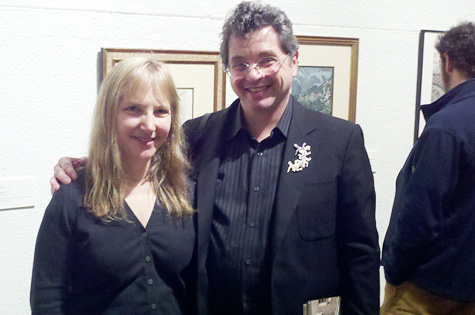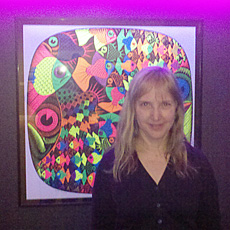Escherphilia

I counted the days until the opening of M.C. Escher: Seeing the Unseen at the Berkshire Museum in Pittsfield, MA. The show contains his classics and some of the rarest Eschers ever in one place—original pencil studies, lithographs, metamorphic scrolls, woodblocks and tzchotkes collected by him, including tiles he hand-painted to make his own tessellation patterns. Black-lit psychedelic posters, applications and appropriations of his work on record albums, magazines, and even polyester shirts convey the dichotomy of Escher as pop artist or master printmaker.
 Escher, as you know is one of my core group of influences. In seventh grade I did a lengthy research paper on him, which I presented to a group of novitiates. I was and am still very entranced by his approach—by Escher’s interest in how we “see” things, his sublime technical prowess in printmaking and drawing, and his apprehension of the natural world. And I am awed by his ability to illuminate and show the continuum to infinity, to illustrate the merger of opposites: sea and sky, day and night, good and evil, two dimensions and three, order and chaos (Order and Chaos, a still life with a giant crystal at its core is one of my favorites.) Escher starts in the physical realm but takes us to the philosophical one. His work is transcendent.
Escher, as you know is one of my core group of influences. In seventh grade I did a lengthy research paper on him, which I presented to a group of novitiates. I was and am still very entranced by his approach—by Escher’s interest in how we “see” things, his sublime technical prowess in printmaking and drawing, and his apprehension of the natural world. And I am awed by his ability to illuminate and show the continuum to infinity, to illustrate the merger of opposites: sea and sky, day and night, good and evil, two dimensions and three, order and chaos (Order and Chaos, a still life with a giant crystal at its core is one of my favorites.) Escher starts in the physical realm but takes us to the philosophical one. His work is transcendent.
Prior to the opening reception, Jeffrey Price, one of the foremost Escher hunters, collectors, dealers and experts, gave an insightful overview of how Escher’s family life, mentoring teachers and travels informed his decision to do what he loved—be an artist. At the show, I got to probe Jeffrey for more details about Escher’s life and work, and share Escherphilia.